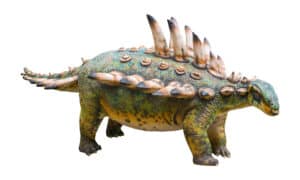Meet the Largest Carnivorous Dinosaur in History (Bigger than a T-Rex!)
@media (min-width: 481px) {
.mobile-top-content {
display: none;
}
}
#mobileTopContentCTACarouselControls { overflow: hidden; text-overflow: ellipsis; white-space: nowrap; }
.mobile-top-content .more { color: #fff; }
.mobile-top-content a { color: #fff; text-decoration: underline; }
.mobile-top-content a:hover { color: #fff; text-decoration: underline; }
@media (max-width: 480px) {
.mobile-top-content {
background-color: #06a10b;
color: #fff;
text-align: center;
/*height: 60px;
padding-top:5px;*/
font-size:80%;
/* display: block; */
margin: 0px -30px;
}
}
The Tyrannosaurus Rex is one of the greatest prehistoric terrors. It is so frightening and violent that it has become a fixed icon in the social imaginary. It has even achieved Hollywood-star-status through the Jurassic Park film series. As terrifying as this land dinosaur is, can you imagine if such a beast could move between both land and water—maybe a type of specialized “River Rex”? Well, it just so happens that scientists have unearthed such a creature. This one, however, is far stranger and larger than even the notorious Tyrannosaurus Rex: meet the Spinosaurus, the largest carnivorous dinosaur in history.
What is a Spinosaurus?
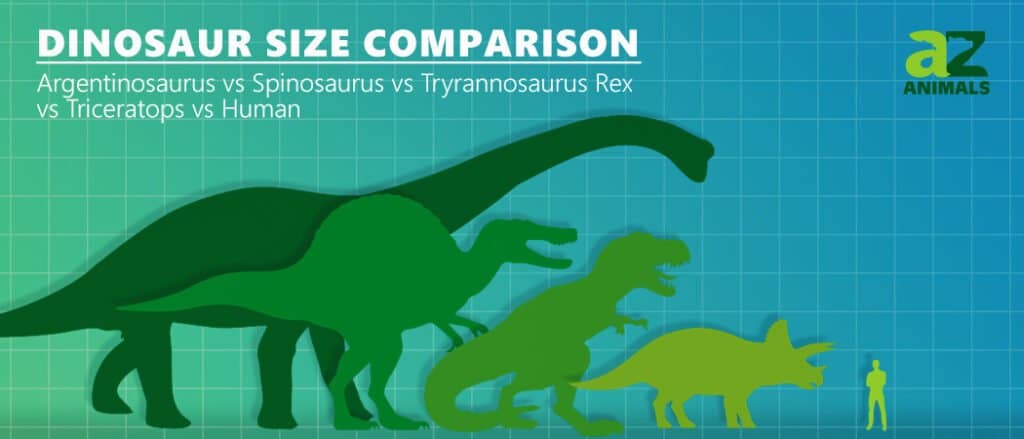
A-Z-Animals.com
The Spinosaurus is a massive carnivorous dinosaur that lived on the earth during the Late Cretaceous Period, at least 93.5-99 million years ago. Its name, Spinosaurus, means “spine lizard.” This refers to the large, spiny, fin-like sail on top of its back, at least 6 feet tall. The Spinosaurus is the largest carnivorous dinosaur we know of. This mammoth dinosaur measures 50 feet in length and weighed 7 ½ tons. It is larger than the Giganotosaurus and the infamous Tyrannosaurus Rex! The Spinosaurus’ narrow skull is 6 feet long alone, shaped like a giant crocodile with straight, conical teeth. Not only was this dinosaur extraordinarily enormous, but it is also the first “land” dinosaur we know of that also lived in the water!
A Unique Discovery
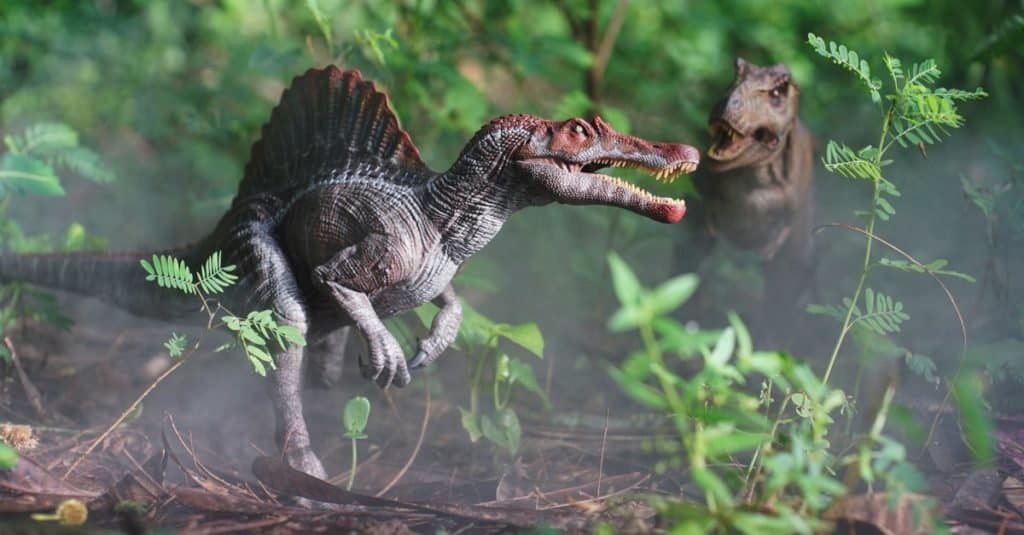
Mercury Green/Shutterstock.com
The first Spinosaurus was discovered during a 1910-1914 paleontology dig in western Egypt, organized by Ernst Freiherr Stromer von Reichenbach. No one had ever seen a dinosaur quite like it. Stromer attempted to reconstruct the Spinosaurus skeleton from the bones his team had collected. Although they had recovered many bones, the body was incomplete, so Stromer relied on information gleaned from other theropod dinosaurs. He reasoned that this large dinosaur stood on its hind legs like a Tyrannosaurus Rex, but a bit more awkwardly and uneven. Stromer’s reconstructed Spinosaurus was a hit in the scientific community and was displayed in the Paleontological Museum in Munich.
Unfortunately, bombing during World War II destroyed the museum and the entirety of the Spinosaurus skeleton. While a few fossilized relatives of the Spinosaurus dinosaur were discovered in the years following the war, none of them belonged to the Spinosaurus. All that remained of this mighty dinosaur were drawings and Stromer’s published descriptions.
A New—and Improved—Spinosaurus
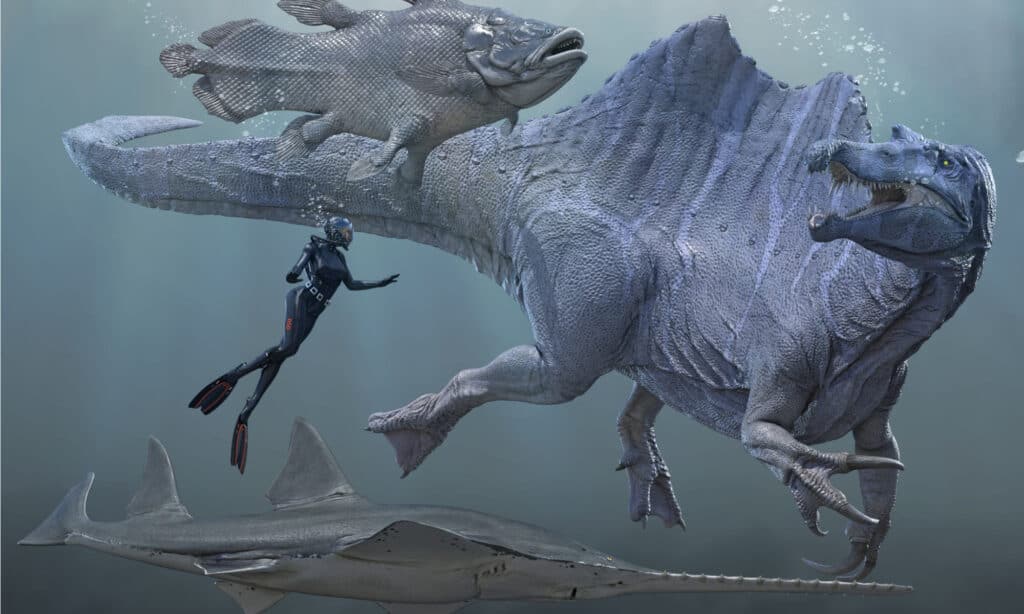
Herschel Hoffmeyer/Shutterstock.com
Nazir Ibrahim, a comparative anatomist and paleontologist, has been fascinated with the Spinosaurus since he was a child. In 2008 he traveled to southeastern Morocco in search of fossils in the Kem Kem Beds. A prehistoric river system once thrived with aquatic life in this area (including fish as large as cars!). Miners in the region dig here and collect fossils to sell to collectors. Ibrahim realized that because these miners work here throughout the year, they had a better chance of making important discoveries than many paleontologists. Ibrahim connected with a miner who had dug up fossils that possibly belonged to a Spinosaurus. Analysis of the bones confirmed that they matched a partial Spinosaurus skeleton from the National History Museum in Milan, Italy.
Ecstatic with this new discovery, Ibrahim returned to Morocco in 2013 with Paul Sereno (head of the University of Chicago’s Fossil Lab) and David Martill (a paleontologist at the University of Portsmouth). As the team discovered more fossilized bones, Ibrahim combined them with other partial discoveries. Referring back to Stromer’s original 1934 descriptions, he reconstructed a new Spinosaurus that was much more complete than the original.
What Does the “New” Spinosaurus Look Like?
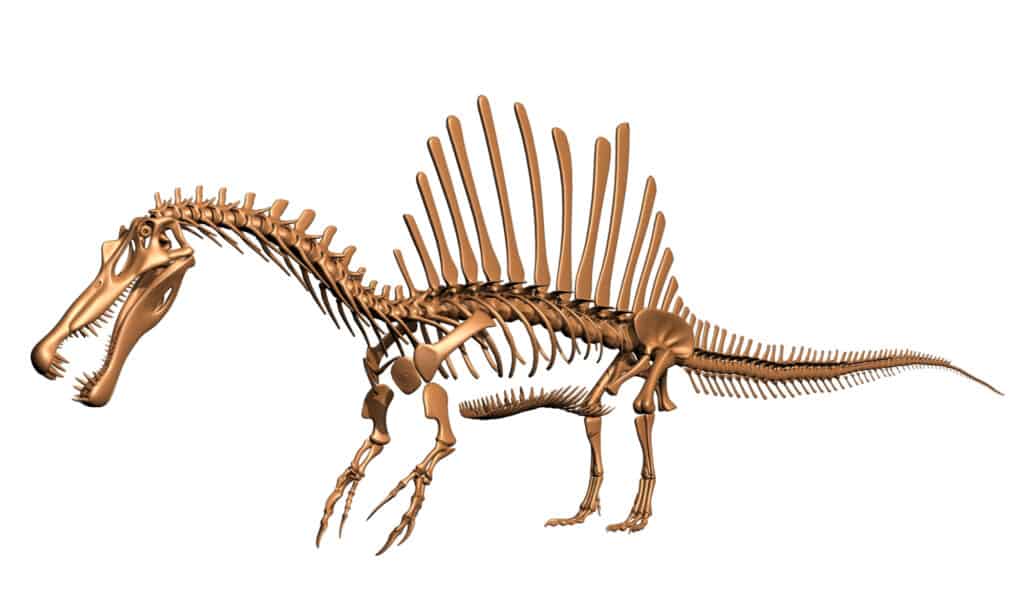
Evgeniy Mahnyov/Shutterstock.com
Ibrahim’s recent discoveries and skeletal reconstruction show that the Spinosaurus is the largest carnivorous dinosaur we know of. It is both longer and heavier than the Tyrannosaurus Rex! The updated skeleton illustrates that the Spinosaurus was long rather than tall, with a slim torso, small pelvis, and short hind legs. The bones themselves are compact and dense. Many semiaquatic animals on the earth today have the same type of bones, like manatees and penguins. This bone composition helps them to better control their buoyancy while underwater. These findings suggest that not only did the Spinosaurus hunt near water sources, but likely spent much of its life in and under the water!
A Semiaquatic Spinosaurus
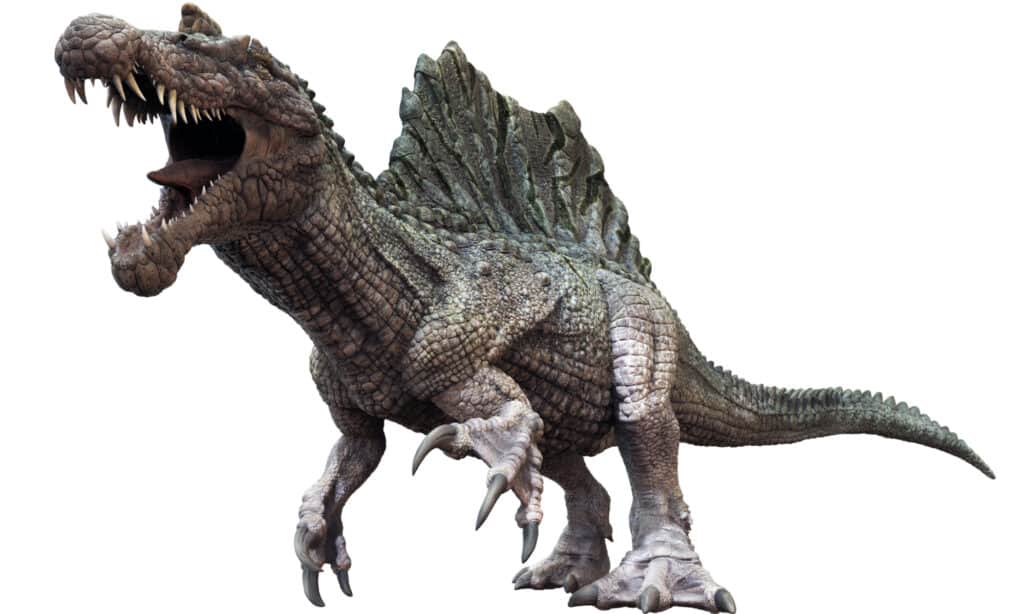
Herschel Hoffmeyer/Shutterstock.com
This new discovery of a water-dwelling Spinosaurus was not easily accepted by the entire scientific community. Ibrahim decided to go back to Morocco to look for more evidence. In 2018, he and his team braved the 115-degree heat and dry desert winds to continue digging through layers and layers of sandstone. At last, the team struck gold, extracting a caudal (or tail) vertebra. Within minutes the team was pulling more and more tail bones from the rock. In the end, more than 30 pieces of tail vertebrae were recovered.
Soon after in 2019, Ibrahim and his team unearthed several Spinosaurus foot bones, as well as tiny vertebrae from the very tip of its tail. They never found matching or duplicate pieces, suggesting that all the bones belonged to the same Spinosaurus dinosaur. Back in the lab Ibrahim pieced the bones together. He realized the Spinosaurus had a much larger tail than originally assumed, and with a surprising shape.
The Spinosaurus’ Aquatic Adaptations
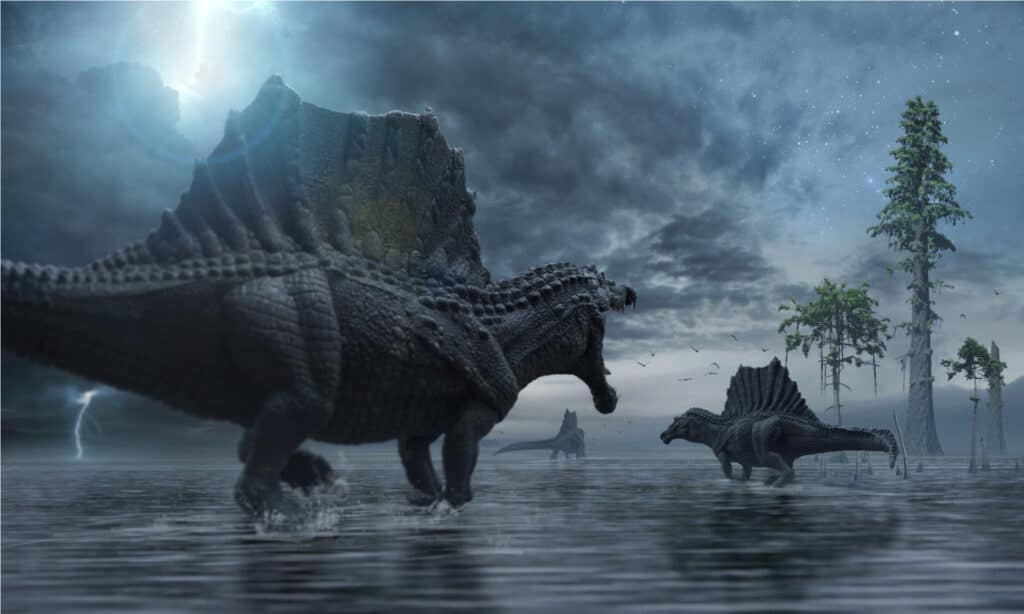
Herschel Hoffmeyer/Shutterstock.com
Ibrahim discovered that the tail bones of the Spinosaurus connected loosely together, providing it with easy, fluid movement. The bones also projected out from the vertebrae in the shape of a giant paddle. Why would a dinosaur need this paddle-shaped tail on land? On the other hand, a large, built-in tail paddle is perfect for navigating through the water with ease.
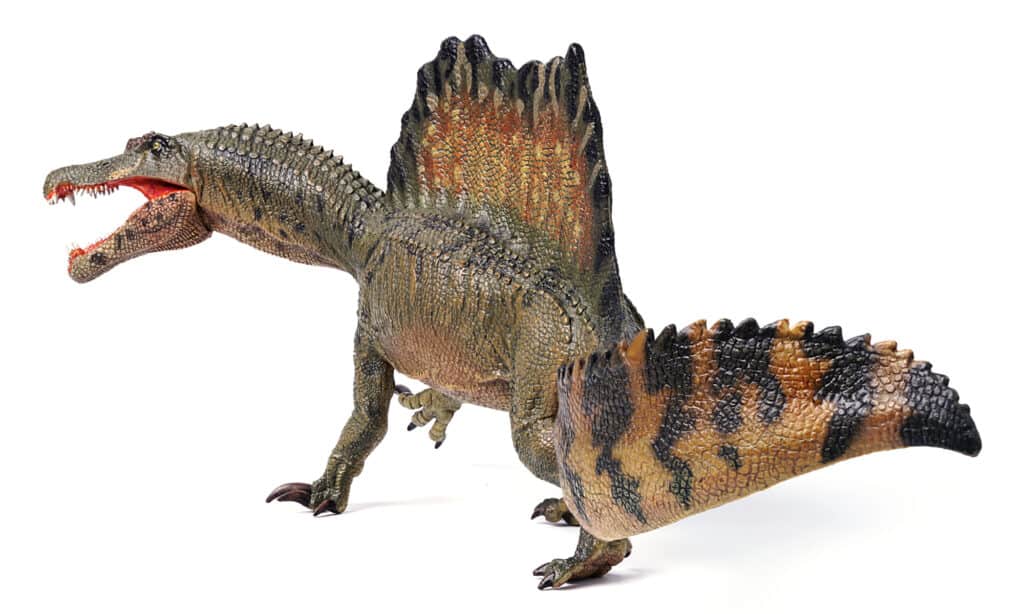
Mercury Green/Shutterstock.com
Piecing the foot bones together was also quite fascinating. The result was a long, strong foot with flat claws, much different than other carnivorous land dinosaurs. In fact, the skeletal anatomy of the Spinosaurus’ feet resembles the foot structure of shorebirds. This suggests that this colossal carnivore may have also had webbed feet, an additional asset for hunting aquatic prey. It is also possible that the large spiny bones on the Spinosaurus’ back functioned as a sail or dorsal fin.
The Spinosaurus in Jurassic Park

Like the Tyrannosaurus Rex, the extraordinary Spinosaurus also makes a Hollywood appearance, stepping in as the antagonist of the 2001 Hollywood film, Jurassic Park III. The Spinosaurus depicted in the film, however, was created long before Ibrahim’s groundbreaking discoveries. As such, the Spinosaurus of Jurassic Park resembles a type of Tyrannosaurus Rex that runs on land with long back legs.
The later 2015 film, Jurassic World, adds an ironic twist on this original misrepresentation of the Spinosaurus. Towards the end of the film, the genetically engineered Indominus Rex chases Owen Grady, Claire Dearing, and Claire’s two nephews through the dinosaur theme park. The camera cuts to Owen warning the boys to be quiet as they hide in one of the gift shops. Behind Owen stands a large Spinosaurus skeleton displayed in the plaza. Claire releases the Tyrannosaurus Rex as one last effort to save everyone. As a clever reference to Ibrahim’s new discovery, the Tyrannosaurus Rex then violently smashes the outdated Spinosaurus skeleton on his way to attack Indominus Rex.
More from A-Z Animals
.more-snake-card-image { max-height:140px !important; }
@media (min-width: 481px) {
.mobile-top-content {
display: none;
}
}
#mobileTopContentCTACarouselControls { overflow: hidden; text-overflow: ellipsis; white-space: nowrap; }
.mobile-top-content .more { color: #fff; }
.mobile-top-content a { color: #fff; text-decoration: underline; }
.mobile-top-content a:hover { color: #fff; text-decoration: underline; }
@media (max-width: 480px) {
.mobile-top-content {
background-color: #06a10b;
color: #fff;
text-align: center;
/*height: 60px;
padding-top:5px;*/
font-size:80%;
/* display: block; */
margin: 0px -30px;
}
}
The Tyrannosaurus Rex is one of the greatest prehistoric terrors. It is so frightening and violent that it has become a fixed icon in the social imaginary. It has even achieved Hollywood-star-status through the Jurassic Park film series. As terrifying as this land dinosaur is, can you imagine if such a beast could move between both land and water—maybe a type of specialized “River Rex”? Well, it just so happens that scientists have unearthed such a creature. This one, however, is far stranger and larger than even the notorious Tyrannosaurus Rex: meet the Spinosaurus, the largest carnivorous dinosaur in history.
What is a Spinosaurus?

A-Z-Animals.com
The Spinosaurus is a massive carnivorous dinosaur that lived on the earth during the Late Cretaceous Period, at least 93.5-99 million years ago. Its name, Spinosaurus, means “spine lizard.” This refers to the large, spiny, fin-like sail on top of its back, at least 6 feet tall. The Spinosaurus is the largest carnivorous dinosaur we know of. This mammoth dinosaur measures 50 feet in length and weighed 7 ½ tons. It is larger than the Giganotosaurus and the infamous Tyrannosaurus Rex! The Spinosaurus’ narrow skull is 6 feet long alone, shaped like a giant crocodile with straight, conical teeth. Not only was this dinosaur extraordinarily enormous, but it is also the first “land” dinosaur we know of that also lived in the water!
A Unique Discovery

Mercury Green/Shutterstock.com
The first Spinosaurus was discovered during a 1910-1914 paleontology dig in western Egypt, organized by Ernst Freiherr Stromer von Reichenbach. No one had ever seen a dinosaur quite like it. Stromer attempted to reconstruct the Spinosaurus skeleton from the bones his team had collected. Although they had recovered many bones, the body was incomplete, so Stromer relied on information gleaned from other theropod dinosaurs. He reasoned that this large dinosaur stood on its hind legs like a Tyrannosaurus Rex, but a bit more awkwardly and uneven. Stromer’s reconstructed Spinosaurus was a hit in the scientific community and was displayed in the Paleontological Museum in Munich.
Unfortunately, bombing during World War II destroyed the museum and the entirety of the Spinosaurus skeleton. While a few fossilized relatives of the Spinosaurus dinosaur were discovered in the years following the war, none of them belonged to the Spinosaurus. All that remained of this mighty dinosaur were drawings and Stromer’s published descriptions.
A New—and Improved—Spinosaurus

Herschel Hoffmeyer/Shutterstock.com
Nazir Ibrahim, a comparative anatomist and paleontologist, has been fascinated with the Spinosaurus since he was a child. In 2008 he traveled to southeastern Morocco in search of fossils in the Kem Kem Beds. A prehistoric river system once thrived with aquatic life in this area (including fish as large as cars!). Miners in the region dig here and collect fossils to sell to collectors. Ibrahim realized that because these miners work here throughout the year, they had a better chance of making important discoveries than many paleontologists. Ibrahim connected with a miner who had dug up fossils that possibly belonged to a Spinosaurus. Analysis of the bones confirmed that they matched a partial Spinosaurus skeleton from the National History Museum in Milan, Italy.
Ecstatic with this new discovery, Ibrahim returned to Morocco in 2013 with Paul Sereno (head of the University of Chicago’s Fossil Lab) and David Martill (a paleontologist at the University of Portsmouth). As the team discovered more fossilized bones, Ibrahim combined them with other partial discoveries. Referring back to Stromer’s original 1934 descriptions, he reconstructed a new Spinosaurus that was much more complete than the original.
What Does the “New” Spinosaurus Look Like?

Evgeniy Mahnyov/Shutterstock.com
Ibrahim’s recent discoveries and skeletal reconstruction show that the Spinosaurus is the largest carnivorous dinosaur we know of. It is both longer and heavier than the Tyrannosaurus Rex! The updated skeleton illustrates that the Spinosaurus was long rather than tall, with a slim torso, small pelvis, and short hind legs. The bones themselves are compact and dense. Many semiaquatic animals on the earth today have the same type of bones, like manatees and penguins. This bone composition helps them to better control their buoyancy while underwater. These findings suggest that not only did the Spinosaurus hunt near water sources, but likely spent much of its life in and under the water!
A Semiaquatic Spinosaurus

Herschel Hoffmeyer/Shutterstock.com
This new discovery of a water-dwelling Spinosaurus was not easily accepted by the entire scientific community. Ibrahim decided to go back to Morocco to look for more evidence. In 2018, he and his team braved the 115-degree heat and dry desert winds to continue digging through layers and layers of sandstone. At last, the team struck gold, extracting a caudal (or tail) vertebra. Within minutes the team was pulling more and more tail bones from the rock. In the end, more than 30 pieces of tail vertebrae were recovered.
Soon after in 2019, Ibrahim and his team unearthed several Spinosaurus foot bones, as well as tiny vertebrae from the very tip of its tail. They never found matching or duplicate pieces, suggesting that all the bones belonged to the same Spinosaurus dinosaur. Back in the lab Ibrahim pieced the bones together. He realized the Spinosaurus had a much larger tail than originally assumed, and with a surprising shape.
The Spinosaurus’ Aquatic Adaptations

Herschel Hoffmeyer/Shutterstock.com
Ibrahim discovered that the tail bones of the Spinosaurus connected loosely together, providing it with easy, fluid movement. The bones also projected out from the vertebrae in the shape of a giant paddle. Why would a dinosaur need this paddle-shaped tail on land? On the other hand, a large, built-in tail paddle is perfect for navigating through the water with ease.

Mercury Green/Shutterstock.com
Piecing the foot bones together was also quite fascinating. The result was a long, strong foot with flat claws, much different than other carnivorous land dinosaurs. In fact, the skeletal anatomy of the Spinosaurus’ feet resembles the foot structure of shorebirds. This suggests that this colossal carnivore may have also had webbed feet, an additional asset for hunting aquatic prey. It is also possible that the large spiny bones on the Spinosaurus’ back functioned as a sail or dorsal fin.
The Spinosaurus in Jurassic Park

Like the Tyrannosaurus Rex, the extraordinary Spinosaurus also makes a Hollywood appearance, stepping in as the antagonist of the 2001 Hollywood film, Jurassic Park III. The Spinosaurus depicted in the film, however, was created long before Ibrahim’s groundbreaking discoveries. As such, the Spinosaurus of Jurassic Park resembles a type of Tyrannosaurus Rex that runs on land with long back legs.
The later 2015 film, Jurassic World, adds an ironic twist on this original misrepresentation of the Spinosaurus. Towards the end of the film, the genetically engineered Indominus Rex chases Owen Grady, Claire Dearing, and Claire’s two nephews through the dinosaur theme park. The camera cuts to Owen warning the boys to be quiet as they hide in one of the gift shops. Behind Owen stands a large Spinosaurus skeleton displayed in the plaza. Claire releases the Tyrannosaurus Rex as one last effort to save everyone. As a clever reference to Ibrahim’s new discovery, the Tyrannosaurus Rex then violently smashes the outdated Spinosaurus skeleton on his way to attack Indominus Rex.

